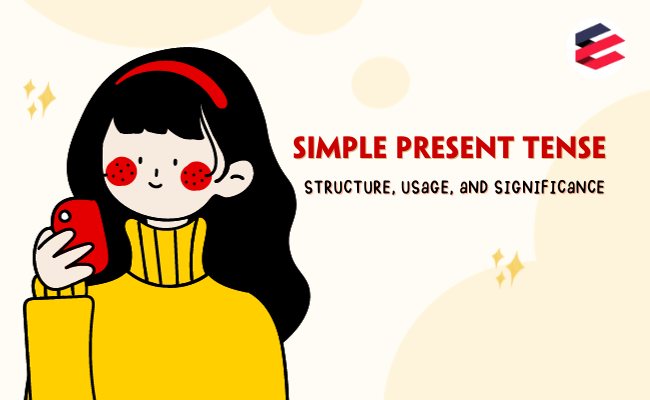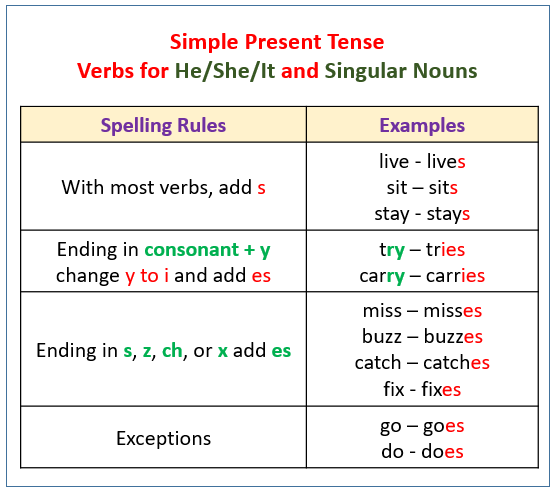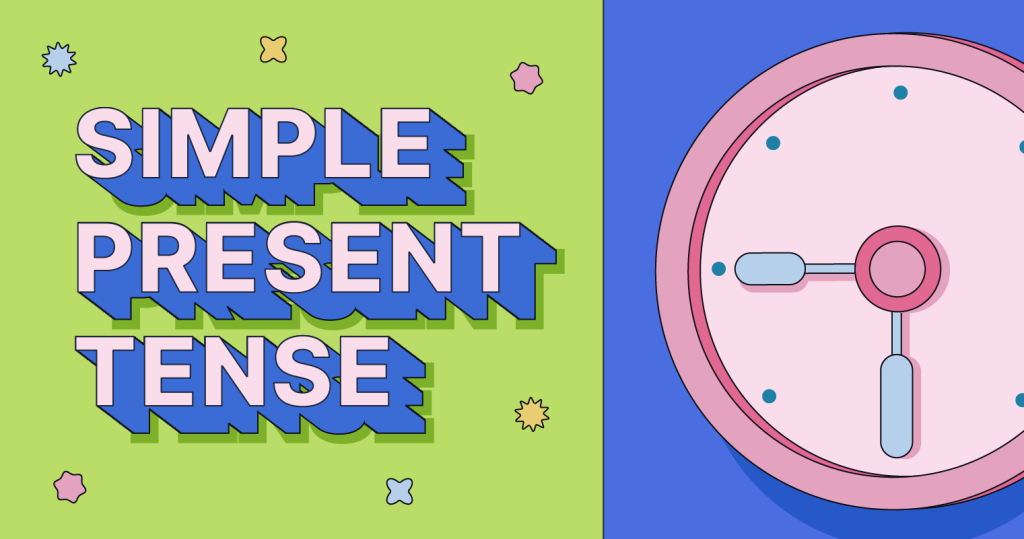The Simple Present Tense: Unveiling Its Structure, Usage, and Significance
Language, as a powerful tool of communication, evolves to express various ideas, emotions, and actions. One of the fundamental aspects of language is tense, which allows us to indicate when an action takes place. Among the different tenses, the simple present tense holds a special place. It serves as a cornerstone in understanding the temporal relationship between actions and their consequences.
This article aims to delve into the intricacies of the simple present tense, exploring its definition, structure, usage, formation, and significance. Additionally, it provides an exercise to test comprehension and addresses frequently asked questions to enhance clarity.

1. Definition of the simple present tense
The simple present tense is a grammatical construct used to express actions, situations, or states that are habitual, factual, or general truths. It describes actions that occur regularly, are constant, or are characteristic of a particular subject. The tense allows us to discuss routines, general truths, scientific facts, and even future events scheduled on a fixed timetable.
2. Structure of the Simple present tense
The structure of the simple present tense is relatively straightforward, making it accessible for learners of varying language proficiency levels. It typically consists of the base form of the verb (infinitive) with slight variations based on the subject. The base form remains unchanged for most verbs, while the third person singular (he, she, it) usually adds an ‘s’ to the verb. Negative and interrogative forms are created using auxiliary verbs.
2.1. Positive
Subject + Verb (+ ‘s’ for third person singular)
- I/We/They dance.
- He/She/It dances.
2.2. Negative
Subject + Do/Does + Not + Verb
- I/We/They do not dance.
- He/She/It does not dance.
2.3. Interrogative
Do/Does + Subject + Base Verb
- Do I/you/we/they dance?
- Does he/she/it dance?
3. What does the Simple present tense use for?
The simple present tense is used to describe actions, situations, or states that are habitual, factual, or general truths. It serves several key functions in communication:
3.1. Present Habits and Routines
The simple present tense is commonly used to describe actions that are habitual or routine. These are activities that occur regularly or repeatedly. For example: “She exercises every morning,” “I brush my teeth twice a day,” or “They have dinner at 7 PM.”
3.2. General Truths and Facts
It is used to express statements that are universally true or factual. These statements often include scientific facts, general knowledge, and information that remains true over time. For instance: “Water boils at 100 degrees Celsius,” “The Earth revolves around the Sun,” or “Dogs are loyal animals.”
3.3. Scheduled Events
The simple present tense can be employed to discuss future events that are part of a fixed schedule or timetable. These events are considered certain to happen. For example: “The flight departs at 9 AM tomorrow,” or “The conference starts on Monday.”
3.4. Narration in Literature
In literature and storytelling, the simple present tense can be used to create a sense of immediacy and vividness. It can give the impression that the events are unfolding right in front of the reader, making the narrative more engaging.
3.5. Historical Present
On occasion, the simple present tense is used in storytelling to describe past events as if they were happening in the present. This is known as the historical present and is often used to add dramatic effect to the narrative.
3.6. Instructions and Manuals
Instructions, guides, and manuals often use the simple present tense to give clear, step-by-step directions. This ensures that readers understand how to perform a task accurately.
3.7. Sports Commentary
Sports commentary frequently employs the simple present tense to describe live actions and events as they happen in a game or match.

4. How the Simple present tense is formed?
Forming the simple present tense involves using the base form of the verb for most subjects. However, for the third-person singular, an ‘s’ is typically added to the base form. This slight alteration serves to distinguish between singular and plural subjects.
5. What is this tense role in the IELTS test?
In the IELTS test, including both the IELTS Academic and IELTS General Training modules, the simple present tense plays a significant role in various sections of the test, including the Speaking, Writing, Listening, and Reading sections. Here’s how the simple present tense is used and assessed in different sections:
5.1. Speaking Section
Part 1: In this section, candidates may be asked about their daily routines, hobbies, and general background information. The simple present tense is commonly used to describe daily habits, routines, and general facts about oneself.
Part 2 (Cue Card): During the individual long-turn task, candidates are given a cue card with a topic to speak about. They may need to use the simple present tense to describe processes, routines, or ongoing situations related to the topic.
5.2. Writing Section
Task 1 (Academic): In the Academic module, Task 1 typically involves describing a graph, chart, table, or diagram. The simple present tense is often used to describe trends and facts presented in the visuals.
Task 1 (General Training): In the General Training module, Task 1 may require writing a letter. The simple present tense is used for routine or factual information in the letter.
Task 2: In both modules, Task 2 is an essay where candidates may use the simple present tense to state general facts, opinions, or trends.
5.3. Listening Section
In the Listening section, candidates will hear various audio recordings, including conversations, lectures, and interviews. The simple present tense is commonly used in these recordings to convey routine actions, facts, and general information. Candidates need to understand and respond to questions related to these tenses.
5.4. Reading Section
The Reading section may include passages that use the simple present tense to convey information about facts, general knowledge, or historical events. Candidates must comprehend the text and answer questions based on it.

6. Challenge yourself with the Simple present tense exercise
Fill in the blanks with the appropriate form of the verbs in the simple present tense.
6.1. Exercise 1: Put the verbs in the correct forms
My sister _______________ (play) the piano every evening.
They _______________ (watch) a movie every Friday night.
The sun _______________ (rise) in the east.
She _______________ (study) diligently for her exams.
Cats _______________ (purr) when they’re content.
He usually _______________ (read) a book before bed.
The train _______________ (arrive) at 7:30 AM every morning.
I _______________ (enjoy) hiking in the mountains.
The company _______________ (produce) high-quality electronics.
Birds _______________ (sing) in the early morning.
6.2. Exercise 2: Fill in the blanks
She _______________ her homework every evening.
We _______________ our best in every situation.
I _______________ my laundry on weekends.
They _______________ a great job at the presentation.
He _______________ his exercises regularly.
Do you _______________ yoga for relaxation?
The team _______________ its best to win the game.
We _______________ everything we can to help.
My brother _______________ his part in community service.
_______________ your parents support your decisions?
6.3. Exercise 3: Fill in the blank:
She _______________ (read) a book every night.
They _______________ (play) soccer on weekends.
He _______________ (watch) documentaries about nature.
We _______________ (study) English grammar.
The cat _______________ (sleep) on the windowsill.
I _______________ (listen) to music while I work.
The sun _______________ (rise) in the morning.
They _______________ (visit) their grandparents regularly.
The company _______________ (produce) high-quality products.
Do you _______________ (like) to travel?
7. Frequently asked questions on simple present tense
Q1: Can the simple present tense be used to describe ongoing actions?
A: No, the simple present tense is not used to describe ongoing or continuous actions. For that, the present continuous tense is used.
Q2: Do all verbs follow the same pattern in the simple present tense?
A: While most verbs follow the regular pattern, some verbs, known as irregular verbs, have unique forms in the present tense. For example, “go” becomes “goes” in the third person singular.
Q3: Can the simple present tense be used to discuss the past or future?
A: While its primary function is to describe present actions, it can also be used to discuss future events that are scheduled and certain to happen.
In conclusion, the simple present tense stands as a foundational component of English grammar. Its definition, structure, usage, and formation are crucial for effective communication. By allowing us to discuss habits, facts, and scheduled events, it serves as a versatile tool. The exercise provided above offers a chance to consolidate your understanding. By addressing frequently asked questions, this essay strives to enhance clarity regarding the simple present tense, paving the way for more effective language usage and comprehension. Create an account and do the IELTS online practice test for more English grammar knowledge!